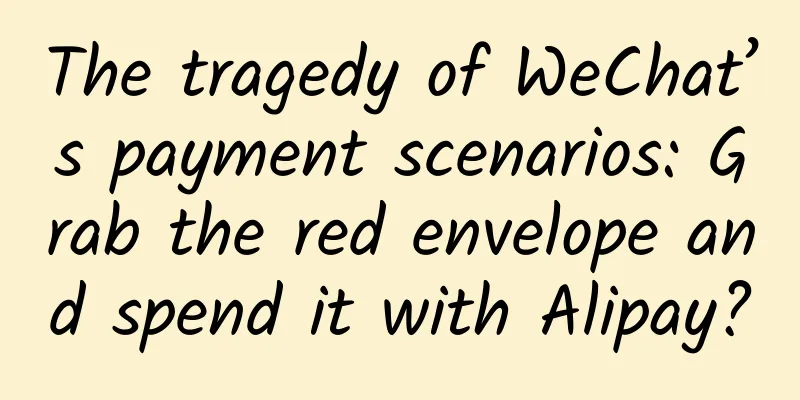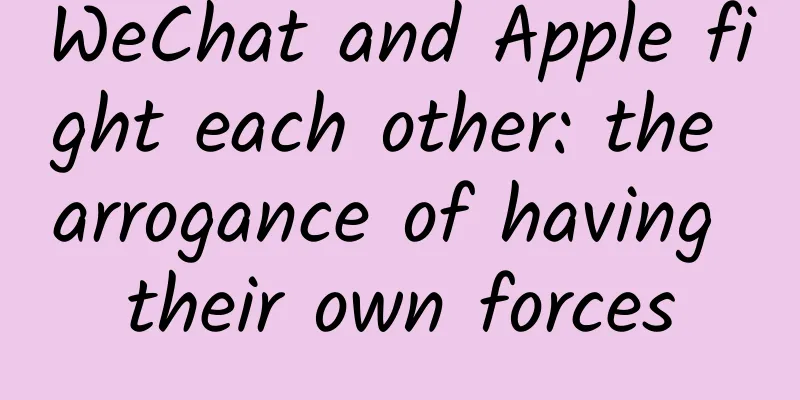The tragedy of WeChat’s payment scenarios: Grab the red envelope and spend it with Alipay?

|
After the New Year's Eve, the fierce red envelope war came to an end. Both sides of the war, WeChat and Alipay, disclosed their own performance reports. WeChat said that on New Year's Eve, the total number of WeChat red envelopes sent and received reached 1.01 billion times, the total number of shakes reached 11 billion times, and the peak reached 810 million times per minute. Alipay disclosed that from 1:00 a.m. on February 18 to 1:00 a.m. on February 19, a total of 683 million people used Alipay red envelopes in 24 hours. In 24 hours, the total number of Alipay red envelopes sent and received reached 240 million, with a total amount of 4 billion yuan. Since the launch of Alipay red envelopes, 1.72 billion people have sent blessings to their friends through Alipay red envelopes. At the peak on New Year's Eve, the Alipay wallet homepage was clicked 883.2 million times per minute. The Chinese red envelopes that Jack Ma distributed at 00:19 on February 19 attracted 29.98 million participants, who entered nearly 100 million answers, of which nearly 15 million entered the correct answer "I". All 999,999 red envelopes were snatched up in 2 minutes and 36 seconds. Judging from the data, the two sides are evenly matched. In the Spring Festival red envelope, Alipay Wallet has become WeChat's only rival, which has made WeChat go from being the only one to fighting hard this year. Judging from the results of the red envelope war between the two sides, both sides have achieved their own goals and made up for their own shortcomings. Red envelopes are connected to money on one end and people on the other. For WeChat, it is a pioneer in payment and e-commerce, while for Alipay, it is a tool to strengthen the relationship chain and social attributes. WeChat continues to promote WeChat payment through red envelopes; Alipay wallet strengthens its own relationship chain through red envelopes. From a long-term strategic perspective, Alipay Wallet is even better. On the one hand, red envelopes do not mean the whole of mobile payments. During the Spring Festival of 2014, WeChat red envelopes became very popular, and there was even a rumor that "it did 8 years of work for Alipay overnight." But the facts have proved that WeChat has taken the market share of mobile payments by using red envelopes. According to statistics from iResearch Consulting, by the end of the third quarter of 2014, Alipay was still the absolute leader in the third-party mobile payment market, with a market share of more than 80%, while WeChat Pay and Tenpay combined accounted for only about 10%. On the other hand, Alipay has incorporated the relationship chain of hundreds of millions of people into its territory through the red envelope war, laying a solid foundation for the future construction of the relationship chain of Alipay Wallet and the exploration of social finance. Previously, Alipay Wallet has always been stronger than WeChat in life consumption scenarios and the financial field. Now that the relationship chain is added, it will be even more powerful. This is a victory at the long-term strategic level. More importantly, Alipay Wallet used the red envelope war to contain WeChat, winning more space for itself to expand into the main battlefield of offline scenarios. WeChat, born from Tencent, has inherited the genes of games and social networking very well, and has brought them to the extreme on the mobile side. The popularity of red envelopes is a good example. However, payment has completely different attributes from games and social networking. Over the years, in the field of games and social networking, we are used to seeing all kinds of high-rise buildings, banquets for guests, and various buildings collapsing. When it comes, it is a gust of wind, and it goes away quickly. In comparison, payment is a slow process. If it wants to take off, it first relies on complex scene construction, which is a slow cooker. This is exactly where WeChat lags far behind Alipay in terms of scenarios. On the e-commerce side, Alipay is supported by the huge transactions of Taobao and Tmall, while after the failure of WeChat's own e-commerce strategy, it can only rely on mercenaries such as JD.com, which it invested in. Not to mention that there is a huge gap between JD.com and Taobao and Tmall in terms of transaction volume, JD.com also has its own payment tools and its own Internet financial calculations. In the offline scenarios that are considered the future of mobile payment, Alipay has covered hospitals, supermarkets, convenience stores, restaurants, transportation, vending machines, universities, retail, shopping malls and other scenarios through the future series such as "Future Hospital", "Future Public Transportation" and "Future Business District", and was able to vigorously promote the "Double 12" and make the aunts and uncles crazy. In comparison, WeChat seems to be able to compete with Alipay-supported Kuaidi only in the taxi scenario through Didi. The disadvantage of offline scene creation has forced WeChat to pay more attention to red envelopes. Although red envelopes were originally an unintentional product, they can help WeChat Pay quickly attract new users and encourage users to bind cards after being combined with social networking. From this point of view, red envelopes have strategic significance for the development of WeChat Pay. As for Alipay on the mobile side, since it has inherited the wealth of the PC side, with more than 300 million real-name users and a huge number of bound cards, the significance of red envelopes is relatively not as important as that of WeChat. The purpose of red envelopes is more to prevent WeChat from breaking through its moat in a single item. For example, red envelopes are of great significance to WeChat Pay, which is still in its early stages of development. They are the "first horse" and "top horse" in many scenarios; for Alipay, they are a tool to contain and harass WeChat, and at most they are a "middle horse". In the battle of red envelopes, Alipay used the "middle horse" to fight against WeChat's "first horse". From a single perspective, it is using its own weaknesses to attack the opponent's strengths, which is very unreasonable. From a larger perspective, it is a clever "Tian Ji horse racing". In order to win the Spring Festival red envelopes this year, WeChat poured a lot of resources into it. Not only did it form a joint fleet with its fellow mobile QQ, it also spent a lot of money and claimed that the total amount of red envelopes issued reached 6.5 billion, of which more than 500 million was in cash. It also sent a team early to discuss cooperation with the Spring Festival Gala and solicited investment everywhere. While WeChat has invested a lot of manpower and financial resources in the Spring Festival red envelopes, which have been proven to be ineffective in increasing the share of mobile payments, Alipay is busy organizing the Double 12 shopping festival, allowing the whole society to feel the heat and power of O2O for the first time. It must be said that Alipay's strategy of sneaking into Chencang after Tian Ji's horse racing was cleverly executed. In fact, a scene during the Spring Festival can illustrate this problem. When the Spring Festival red envelopes rained down, Alipay used the "poke" method to compete with WeChat's "shake" method, but in another battlefield, the scene of mobile payment has been deployed overseas. During the Spring Festival, people traveling in South Korea, Singapore, Thailand, Hong Kong, and Macau, whether eating, riding, drinking coffee, buying cosmetics, or scanning diapers, used Alipay wallets or overseas transportation cards purchased with Alipay wallets to pay, all of which were 50% off. There were a total of 200,000 participating stores. The Korean "JoongAng Ilbo" also exclaimed that Chinese people used Alipay to travel and shop in South Korea, and worried that Koreans would join in. If WeChat is still limited to Spring Festival red envelopes, instead of working hard to build more arduous O2O offline scenarios, can we imagine this scenario next year: grab the red envelopes on WeChat and then spend them on Alipay. [Editor: chenqingxiang TEL: (010) 68476606] |
<<: Why is it harder to grab red envelopes this year? Plugins are the culprit
>>: WeChat red envelopes have only a tiny relationship with payment
Recommend
Do you have a special liking for poultry? Be careful of "parrot fever" knocking on your door! Here are some tips on how to prevent it~
Experts from Yiyang Central Hospital remind peopl...
Talk about four kinds of App product designs that will never die if you don’t do it
[[120114]] 1. Superfluous products This kind of p...
Brand Marketing Promotion: How to design a poster?
Nowadays, countdowns are widely used, including b...
PR Event Planning Guide
It is not difficult for PR professionals to carry...
Why don’t Huawei and Xiaomi make mobile phones for men?
Previously, there was a picture circulating on th...
See the strong insertion of AspectJ in Android
What is AOP AOP is the abbreviation of Aspect Ori...
Users complain about iOS 9 bugs and lags
[[149781]] At the previous Apple press conference...
Stranger social networking and new media operations are inseparable
New media operations basically revolve around fan...
Weibo released a mobile phone report, and fewer and fewer people use iPhones
There is another new smartphone report, and this ...
Weilong Spicy Tiao Mobile Game is here!
While many traditional companies are still doing ...
After spending money, how can we judge the effectiveness of promotion?
You know that half of your advertising budget is ...
Durex was fined 810,000 yuan. How long will its “borderline” marketing continue to be popular?
If you walk by the river often, you will get your...
How to make a good online event promotion plan?
In marketing psychology, herd mentality, the ment...
Tencent advertising strategy for the wedding photography industry
1. The market size of the wedding photography ind...
How to better cultivate users' ability and habits to pay?
Today we are going to talk about a common and rel...









